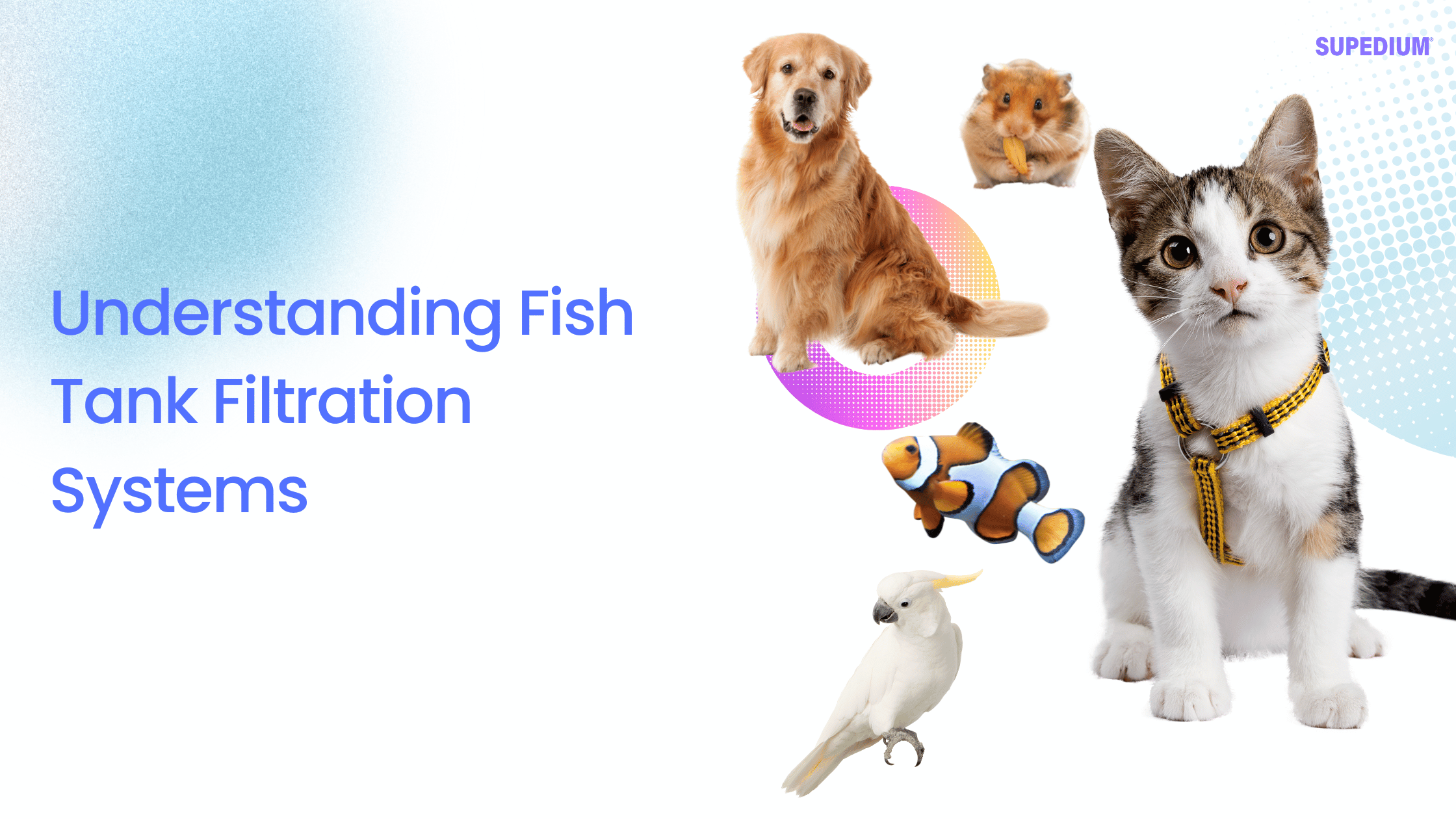Table of Contents
![]()
Maintaining a healthy aquarium is a delicate balance of ensuring proper water quality, providing a safe environment for fish, and supporting the overall ecosystem. A key component in achieving this balance is the fish tank filtration system. Filtration plays a vital role in removing waste, controlling toxins, and supporting beneficial bacteria that help break down harmful substances. This article explores the different types of filtration systems, how they work, and how to choose the right one for your tank.
Types of Fish Tank Filtration Systems
Mechanical Filtration
Mechanical filtration refers to the process of physically removing debris and particulate matter from the water. It is the first line of defense in keeping the aquarium water clear. Common forms of mechanical filter media include sponges, filter pads, and cartridges that trap dirt and debris as water flows through them.
Common filters that utilize mechanical filtration include internal filters, canister filters, and hang-on-back (HOB) filters. While they are excellent at removing visible waste like uneaten food, plant matter, and fish waste, they need to be cleaned regularly to prevent clogging and maintain efficiency. Mechanical filtration is essential for keeping the water clear but does not address dissolved toxins or support biological filtration.
Biological Filtration
Biological filtration is arguably the most critical aspect of keeping your fish healthy. It relies on beneficial bacteria that break down harmful substances such as ammonia and nitrites, which are toxic to fish. This process, known as the nitrogen cycle, transforms toxic ammonia into less harmful substances.
- Ammonia is first converted to nitrites by Nitrosomonas bacteria.
- Nitrites are then converted into nitrates by Nitrobacter bacteria, which are generally less toxic and can be safely removed through water changes.
Biological filtration typically uses filter media that provide a large surface area for bacteria to colonize, such as ceramic rings, bio-balls, and sponge filters. Since biological filtration is a gradual process, it requires time to develop after the tank is set up. It’s essential for long-term tank health and is often the most self-sustaining form of filtration.
Chemical Filtration
Chemical filtration focuses on removing dissolved toxins and impurities that mechanical and biological filtration cannot address. This includes compounds like chlorine, chloramines, heavy metals, and dissolved organic waste. Common filter media used for chemical filtration are activated carbon, zeolite, and resins.
Activated carbon, for instance, works through adsorption, trapping chemicals and impurities in its porous surface. Chemical filtration is beneficial for specific problems, such as controlling odors, clearing discoloration, and removing medications after treatment. However, it is not a substitute for biological or mechanical filtration and should be used in conjunction with these other methods.
Integrated Filtration Systems
Many modern filters combine mechanical, biological, and chemical filtration in a multi-stage process to provide comprehensive water treatment. These integrated filtration systems, such as canister filters and HOB filters with multi-stage capabilities, ensure that the water remains clean, clear, and safe for fish. By combining all three filtration types, these systems offer superior efficiency and are easier to maintain than separate filtration systems.
Components of a Filtration System
Filter Housing
The filter housing is the outer casing that holds the filter media and pump. It can either be external or internal:
- External filters (such as canister filters) are typically placed outside the tank, offering larger capacity and flexibility for customization.
- Internal filters are placed inside the tank, making them suitable for smaller setups but limited by size and media options.
The design of the filter housing influences its ease of use, water flow, and maintenance access. When choosing a filter housing, consider tank size, flow rate, and the type of fish or plants in your aquarium.
Filter Media
Filter media are the materials inside the filter that facilitate mechanical, biological, and chemical filtration. They come in various forms depending on the type of filtration:
- Mechanical media includes sponges, floss, and filter pads designed to trap particles.
- Biological media consists of porous materials like ceramic rings, bio-balls, or sintered glass, which provide a large surface area for beneficial bacteria.
- Chemical media includes activated carbon, zeolite, and specific resins for absorbing toxins.
Filter media need to be cleaned or replaced periodically to ensure effective filtration. Biological media should be cleaned sparingly to avoid disrupting the bacteria colonies.
Water Pump or Flow System
The water pump is responsible for circulating water through the filter system. The size and power of the pump should match the tank size and the filtration system’s requirements. Flow rate is critical to ensuring proper filtration; if the flow is too strong, it can stress delicate fish, while too weak a flow can lead to inadequate filtration.
Some tanks require adjustable flow rates, especially for species that prefer calm waters, while others may need higher flow for species like cichlids or marine tanks that thrive in more turbulent environments.
Additional Accessories
Some filtration systems also include additional accessories, such as heaters for maintaining water temperature and UV sterilizers to control algae and pathogens. Pre-filters, which trap larger debris before it reaches the main filter, are also useful in preventing clogging and improving filter lifespan.
Choosing the Right Filtration System
Selecting the right filtration system is essential for maintaining a healthy aquarium. The best system for your tank depends on several factors.
Tank Size and Type
The size of your tank is a key consideration in choosing a filter. Larger tanks require more powerful filters, while smaller tanks benefit from compact systems. Additionally, consider the type of tank:
- Saltwater tanks often need stronger filtration due to higher bioloads.
- Freshwater tanks may have less complex filtration needs depending on the fish species.
Fish Species and Bioload
The type of fish in your aquarium greatly impacts filtration requirements. Fish with a high bioload, such as goldfish or cichlids, produce more waste and require more efficient filtration systems. In contrast, small, low-maintenance fish like guppies or bettas have lower filtration demands.
Filtration Capacity and Flow Rate
Match the filtration capacity to the size of your tank. A general guideline is to choose a filter that can process the entire tank’s water volume 4 to 5 times per hour. Pay attention to the flow rate, as certain species may not tolerate strong currents.
Filter Features and Ease of Maintenance
Consider the ease of cleaning and maintaining the filtration system. Filters that are easy to disassemble and clean will save time and effort in the long run. Features like noise reduction, energy efficiency, and ease of installation can also enhance your aquarium experience.
Setting Up and Installing a Filtration System
Once you’ve selected the right filtration system, it’s time to set it up.
Placement of the Filter
Position the filter to ensure optimal water circulation throughout the tank. For external filters, place them below the tank to take advantage of gravity for water flow. For internal filters, ensure the water is drawn through the entire tank to prevent stagnant areas.
Installing the System
Follow the manufacturer’s instructions for setting up hoses, filters, and media. Priming the filter is crucial for external filters; it involves manually filling the filter with water before starting it to ensure proper operation. Once installed, check the system for leaks and ensure the water is flowing as intended.
Start-up Process
Monitor the filter during the first few days to ensure it’s working effectively. Regularly check water quality, especially for ammonia, nitrite, and nitrate levels. Initial water tests will help you identify any issues early on.
Maintenance of Filtration Systems
Routine Cleaning and Maintenance
Regular maintenance is essential for optimal filter performance. Clean mechanical filter media regularly to prevent clogging, but avoid cleaning biological media too frequently, as this can disrupt beneficial bacteria. Replace chemical media as needed, and clean the pump and hoses to remove any debris.
Troubleshooting Common Issues
If the filter is producing low water flow, it could be clogged with debris. Noisy filters may require cleaning or may indicate that the pump is malfunctioning. Persistent cloudy water may point to an issue with biological filtration or an overload of organic matter in the tank.
Water Testing and Monitoring
Perform regular water tests to monitor ammonia, nitrite, nitrate, and pH levels. Adjust the filtration system if the readings are off, or if certain parameters are consistently outside the ideal range for your fish.
Advanced Filtration Options
For larger tanks or specialized setups, advanced filtration options may be necessary.
Sumps and Refugiums
Sumps are external filtration units typically used for saltwater or large freshwater tanks. They offer additional space for filtration media and can incorporate various filtration types, such as protein skimmers. Refugiums are separate sections of the sump that provide a habitat for beneficial organisms like copepods and algae, which help maintain water quality.
UV Sterilizers
UV sterilizers use ultraviolet light to kill harmful bacteria, viruses, and algae. They’re commonly used in tanks with high fish density or in tanks prone to algae blooms.
Protein Skimmers (for Saltwater Aquariums)
Protein skimmers are essential for removing organic waste before it breaks down into harmful compounds. They are particularly useful in saltwater aquariums, where fish and invertebrates tend to produce high levels of waste.
Conclusion
Proper filtration is crucial for creating and maintaining a healthy aquarium environment. By understanding the types of filtration systems, components, and maintenance requirements, aquarium owners can make informed decisions that benefit both the tank’s ecosystem and its inhabitants. Whether you’re caring for a small freshwater tank or a large marine setup, choosing the right filtration system and maintaining it regularly will ensure long-term success and vibrant, thriving fish.
Share This





Be the first to comment